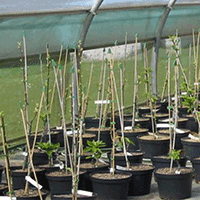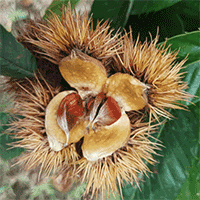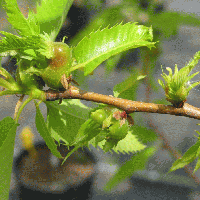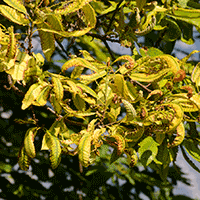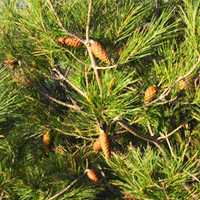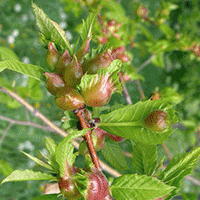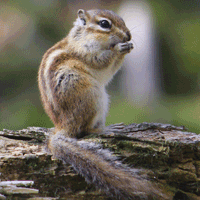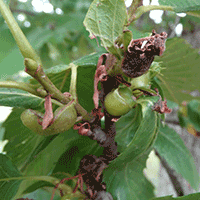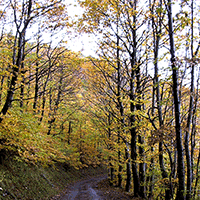
Does management improve the state of chestnut (Castanea sativa L.) on Belasitsa Mountain, southwest Bulgaria?
Tzvetan Zlatanov (1) , Ivaylo Velichkov (1), Margarita Georgieva (1), Georgi Hinkov (1), Magdalena Zlatanova (1), Georgi Gogusev (2), Chris S Eastaugh (3)
iForest - Biogeosciences and Forestry, Volume 8, Issue 6, Pages 860-865 (2015)
doi: https://doi.org/10.3832/ifor1420-008
Published: Apr 27, 2015 - Copyright © 2015 SISEF
Research Articles
Abstract
Chestnut forests in the Belasitsa Mountain region of southwest Bulgaria were traditionally intensively managed as orchard-like stands for nut production. More recently, management intensity has been sharply reduced as a result of rural abandonment, which combined with the effects of chestnut blight has led to marked structural changes in these forests. The focus of this paper is on the seed-based regeneration potential and seedling survival of chestnut in mixed stands managed over the past 15 years. Results suggest that management of stands under a high-forest system is appropriate, and regeneration from seed has advantages over coppicing if competing species can be controlled. An investigation into “sanitation cutting” performed since the 1990s shows that this had not a successful response to blight infestations.
Keywords
Castanea sativa, Chestnut Blight, High-forest System, Seed-based Regeneration
Authors’ Info
Authors’ address
Ivaylo Velichkov
Margarita Georgieva
Georgi Hinkov
Magdalena Zlatanova
Forest Research Institute - Sofia, 132 St. Kliment Ohridski Blvd., 1756 Sofia (Bulgaria)
Regional Forest Directorate, Blagoevgrad (Bulgaria)
School of Environment, Science and Engineering, Southern Cross University, PO Box 157, Lismore NSW 2480 (Australia)
Corresponding author
Paper Info
Citation
Zlatanov T, Velichkov I, Georgieva M, Hinkov G, Zlatanova M, Gogusev G, Eastaugh CS (2015). Does management improve the state of chestnut (Castanea sativa L.) on Belasitsa Mountain, southwest Bulgaria?. iForest 8: 860-865. - doi: 10.3832/ifor1420-008
Academic Editor
Alberto Santini
Paper history
Received: Aug 04, 2014
Accepted: Jan 23, 2015
First online: Apr 27, 2015
Publication Date: Dec 01, 2015
Publication Time: 3.13 months
Copyright Information
© SISEF - The Italian Society of Silviculture and Forest Ecology 2015
Open Access
This article is distributed under the terms of the Creative Commons Attribution-Non Commercial 4.0 International (https://creativecommons.org/licenses/by-nc/4.0/), which permits unrestricted use, distribution, and reproduction in any medium, provided you give appropriate credit to the original author(s) and the source, provide a link to the Creative Commons license, and indicate if changes were made.
Web Metrics
Breakdown by View Type
Article Usage
Total Article Views: 51587
(from publication date up to now)
Breakdown by View Type
HTML Page Views: 43215
Abstract Page Views: 3258
PDF Downloads: 3655
Citation/Reference Downloads: 21
XML Downloads: 1438
Web Metrics
Days since publication: 3882
Overall contacts: 51587
Avg. contacts per week: 93.02
Citation Metrics
Article Citations
Article citations are based on data periodically collected from the Clarivate Web of Science web site
(last update: Mar 2025)
Total number of cites (since 2015): 4
Average cites per year: 0.36
Publication Metrics
by Dimensions ©
Articles citing this article
List of the papers citing this article based on CrossRef Cited-by.
References
La sostenibilità della produzione legnosa di qualità dal ceduo di castagno: modello alternativo al ceduo a turno breve [The sustainability of timber production quality from chestnut coppice: alternative model to short rotation coppice]. In: “Atti del Convegno Nazionale sul Castagno”. Cison di Valmarino (Treviso, Italy) 23-25 Oct 1997, pp. 217-230. [in Italian]
Gscholar
Alternative silvicultural systems in chestnut coppice: effects of silvicultural practices on stand structure and tree growth. Ecologia Mediterranea 26 (1-2): 155-162.
Gscholar
Améliorer les taillis de chataignier [Improve chestnut coppice]. Forêt Entreprise 44: 8-15. [in French]
Gscholar
Visual assessment of crown condition and damaging agents. Manual Part IV. In: “Manual on methods and criteria for harmonized sampling, assessment, monitoring and analysis of the effects of air pollution on forests”. UNECE ICP Forests Programme Co-ordinating Centre, Hamburg, Germany, pp. 49. [ISBN 978-3-926301-03-1]
Gscholar
Health condition of European chestnut dominated forests in the Bulgarian part of Belasitsa Mountain. In: “State and prospects of the Castanea sativa population in Belasitsa mountain: climate change adaptation; maintenance of biodiversity and sustainable ecosystem management” (Zlatanov T, Velichkov I, Nikolov B eds). Project BG 0031 EEA report, Forest Research Institute, Sofia, Bulgaria, pp. 27.
Online | Gscholar
Effect of Cryphonectria parasitica (Murrill.) Barr. on the health condition of chestnut (Castanea sativa Mill.) on the northern slopes of Belasitsa Mountain. Forest Science 1 (2): 73-87.
Gscholar
Silvics of Silver lime (Tilia tomentosa Moenh) in North-eastern Bulgaria. PhD thesis, Forest Research Institute, Sofia, Bulgaria, pp. 162 [in Bulgarian].
Gscholar
Preservation of chestnut (Castanea sativa Mill.) genetic resources and adaptive potential in relation to environmental changes. In: Proceeding of the “1st European Congress on Chestnut” (Bounous G, Becarro G eds). ISHS Acta Horticulturae 866: 677-682.
Online | Gscholar
Quality wood production from chestnut (Castanea sativa Mill.) coppice forests - Comparison between different silvicultural approaches. In: Proceeding of the “1st European Congress on Chestnut” (Bounous G, Becarro G eds). ISHS Acta Horticulturae 866: 683-692.
Online | Gscholar
Randomization, bootstrap and Monte Carlo methods in biology. Chapman and Hall, London, UK, pp. 399.
Gscholar
Ecological and silvicultural characteristic of Castanea sativa Mill. forests in South-western Bulgaria. PhD thesis, Forest Research Institute, Sofia, Bulgaria, pp. 180.
Gscholar
Bird density and species composition in Sweet Chestnut (Castanea sativa) dominated forests in the Bulgarian part of Belasitsa Mountain. In: “State and prospects of the Castanea sativa population in Belasitsa Mountain: climate change adaptation; maintenance of biodiversity and sustainable ecosystem management” (Zlatanov T, Velichkov I, Nikolov B eds). Project BG 0031 EEA report, Forest Research Institute, Sofia, Bulgaria, pp. 29.
Online | Gscholar
Forest stand dynamics. Biological Resources Management Series, McGraw-Hill, New York, USA, pp. 467.
Gscholar
Note sull’ecologia del Castagno [Notes on the ecology of chestnut]. Economia Montana 24: 15-17. [in Italian]
Gscholar
Cryphonectria parasitica (Murril) on chestnut (Castanea sativa Mill.) in Bulgaria. Forest Science 4: 83-87. [in Bulgarian]
Gscholar
“Castanea sativa woods” in the Northern Apennines: a phytosociological analysis along ecological gradients. In: Proceeding of the “1st European Congress on Chestnut” (Bounous G, Becarro G eds). ISHS Acta Horticulturae 866: 551-559.
Online | Gscholar
“Petrich” Forest Enterprise Management Plan. Agrolesproekt, Sofia, Bulgaria. [in Bulgarian]
Gscholar
Animal (spiders, beetles, butterflies and birds) assemblage patterns and environmental gradients in sweet chestnut dominated forests in the Bulgarian part of Belasitsa Mountain. In: “State and prospects of the Castanea sativa population in Belasitsa Mountain: climate change adaptation; maintenance of biodiversity and sustainable ecosystem management” (Zlatanov T, Velichkov I, Nikolov B eds). Project BG 0031 EEA report, Forest Research Institute, Sofia, Bulgaria, pp. 81.
Online | Gscholar
Factors affecting biodiversity in chestnut (Castanea sativa Mill.) ecosystems along a gradient from coppice to orchard in the Cevennes mountains (Southern France). In: “Sustainability of Mediterranean ecosystems, case study of the chestnut forests” (Romane F ed). Ecosystem Research Report 19 EUR 15727 EN, Office for Official Publications of the European Communities, Luxembourg, pp. 103-108.
Gscholar
Results of first study of biodiversity of bats (Mammalia: Chiroptera) in chestnut forests, Belasitsa Mountain. In: “State and prospects of the Castanea sativa population in Belasitsa Mountain: climate change adaptation; maintenance of biodiversity and sustainable ecosystem management” (Zlatanov T, Velichkov I, Nikolov B eds). Project BG 0031 EEA report, Forest Research Institute, Sofia, Bulgaria, pp. 13.
Online | Gscholar
The practice of silviculture (8th edn). John Wiley & Sons, New York, USA, pp. 527.
Gscholar
Flora and vegetation in Middle Danube Plain between rives of Vit and Studena. PhD thesis, University of Sofia, Sofia, Bulgaria, pp. 174. [In Bulgarian]
Gscholar
State and prospects of the Castanea sativa population in Belasitsa Mountain: climate change adaptation; maintenance of biodiversity and sustainable ecosystem management. Forest Research Institute - BAS, Sofia, Neo-Art, Silistra, Bulgaria, pp. 34. [In Bulgarian]
Gscholar
State of chestnut (Castanea sativa Mill.) in mixed deciduous thickets in Belasitsa Mountain. Forest Science 1 (2): 23-36.
Gscholar

